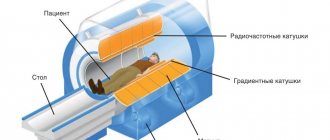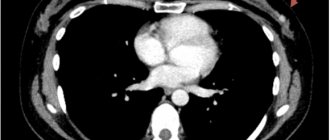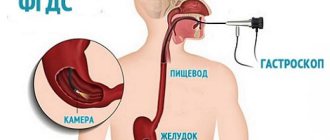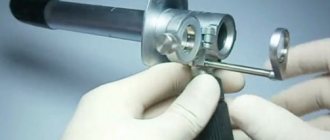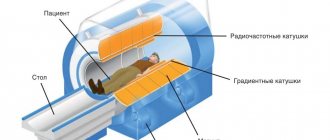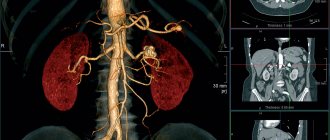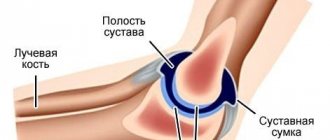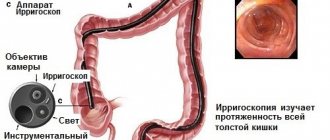How not to confuse it with ordinary caries? Diagnosis of tooth pulpitis
Pulpitis is an inflammation of the dental pulp, conventionally it is also called a nerve . In the first stages, this disease makes itself felt when the teeth are exposed to various irritants (for example, temperature changes).
This causes a painful reaction . With progressive pulpitis, paroxysmal acute pain is observed.
Based on the fact that pain quite often covers the entire jaw, it is difficult to determine which tooth is inflamed. The disease can be identified by external symptoms: tissue growth occurs in an open carious cavity, the enamel turns grey, and the tooth bleeds.
Regular visits to the dentist, even if there are no signs of disease, and adherence to good oral hygiene will help avoid the progression of caries, which is an excellent prevention of pulpitis.
How to remove white spots on front and back teeth: dental treatment
If the cause of pigmentation is superficial caries, which means a deficiency of fluoride and calcium in the patient’s body, then the dentist carries out remineralizing therapy. Its goal is to restore the balance of minerals and strengthen the enamel.
The procedure is as follows:
- professional teeth cleaning. It includes the removal of mineralized plaque;
- the strengthening procedure itself. The dentist applies a special material (gel, paste, calcium-magnesium composition or fluoride varnish) to the enamel;
- drying.
Other methods of strengthening tooth enamel:
- ozonation . This method is used to disinfect the oral cavity. The gas makes teeth almost sterile in a matter of seconds. Then the cleaned enamel is coated with a special compound to strengthen it;
- ICON . The procedure is innovative and does not require a drill. An infiltrate is applied to the prepared tooth, which, penetrating into the pores at the site of the caries lesion, makes the tissue hard. The enamel is healthy again;
- electrophoresis. Prescribed for fluorosis. In this case, the enamel tissue is saturated with active ions from a special aqueous agent under weak currents.
If fluorosis is at an advanced stage, a special mineralized composition is applied to the teeth to strengthen the dentin. For aesthetics, tooth restoration (veneers or microprostheses) may also be necessary.
How to recognize tooth pulpitis: diagnosis of the disease
For successful diagnosis of the disease, it is important to determine the primary source of occurrence , intensity and frequency of attacks.
Attention! Pulp inflammation can develop into a serious disease such as periodontitis. Then the inflammation moves from the nerve to the apex of the tooth root.
X-ray: what does the pathology look like, is it visible on the X-ray?
Since with pulpitis the inflammatory process does not lead to any transformations in hard tissues, it does not have direct symptoms that can be seen on x-rays . However, it can be determined by indirect signs. For example, in the picture it is a deep carious cavity communicating with the tooth cavity.
Photo 1. This is what pulpitis looks like on an x-ray. The affected area of the tooth is marked in red.
On x-ray, caries has various manifestations, it all depends on what form it takes:
- With average caries, darkening occurs, which is localized exclusively within the dentin.
- If the image showed that dark areas communicate with the pulp chamber, then these are deep carious lesions. Occasionally, the cavity of the neurovascular bundle has a subtle darkening.
- Secondary caries. X-ray lesions have uneven contours and noticeable light areas next to them. If the border between the cavity and the filling has a defect, this is a sign of pathological changes in the tissues.
- The wedge-shaped white stripe is a gap that is located near the neck of the tooth.
- An x-ray image most clearly shows damage to the chewing (occlusal) surface . They take on a V-shape at one stage of the disease.
A few clinical data are not enough to identify the disease . For the diagnosis to be accurate, we need the results of probing the pulp and determining its electrical excitability .
The reason for the appearance of denticles is the degenerative processes that occur in the pulp.
Denticles can be parietal, which are located near the walls of the root canal and dental cavity, and free, located freely in the pulp. On an x-ray, they are caused by many or single dense shadows of a roundish shape against the background of a tooth cavity or root canal.
One of the main causes of tooth destruction (“internal granuloma”) is chronic granulomatous pulpitis . Most often, damage of this nature can be found with inflamed pulpitis of the front teeth. On an x-ray, it is clearly defined by a rounded lightening, which is projected onto the tooth cavity.
Temperature
Temperature diagnostics are based on the use of carbon dioxide at -70 °C or dichlorodifluoromethane at -40 °C . When cold affects the affected area, the clinical picture of the disease changes. The test is repeated when sensitivity and perception are restored. If the pain decreases from low temperatures , then this is a sure sign of pulp necrosis. In rare cases, the tooth is immersed in a water bath, and the gums are isolated from it with a rubber dam. In this way, a reaction from heat is checked.
Electroodontodiagnosis or EDI
When the coronal pulp is damaged by electric current, its electrical excitability reaches 7-60 μA .
Photo 2. The EDI process: the doctor applies a special device to the patient’s tooth that sends electrical signals.
With appropriate symptoms, even a slight decrease in electrical excitability to 20-25 μA indicates a limited process, that is, focal pulpitis, as well as inflammatory changes that are reversible. The process is widespread in the coronal pulp if electrical excitability is reduced to 25-60 μA. With a reaction of 61-100 μA, the death of the coronal pulp occurs with the transition of the inflammatory process to the root pulp.
Reference. The final death of the pulp occurs at 101-200 μA, periodontal receptors in this case react to the current. There is no electrical excitability if there are periapical changes. An example is periodontitis or radicular cyst. This diagnostic method is the most accurate.
What are the consequences of abstaining from visiting a doctor?
Delaying a visit to the dentist for too long can lead to the development of multiple caries, which is unlikely to add attractiveness to anyone:
..
Here is another photo showing simultaneous damage to several teeth by deep caries:
And here is acute caries on the child’s front teeth:
Do not forget that initial caries in the spot stage usually responds easily to remineralization therapy at the dentist and can be treated without preparing the tooth with a drill. The same cannot be said about deep carious lesions, which can not only cause pain from various irritants, but also develop into a serious complication - pulpitis, when emergency care is often required, since such pain can be unbearable.
The dentist tells
Many people often wonder: can a dentist treat his own tooth? I declare with authority that such cases occur in practice if the dentist does not trust anyone but himself, or does not have enough funds for these procedures, working in a small town or village.
I can say from personal experience that treating caries on yourself is a difficult task. You can only take risks if the working field is clearly visible and the cavity does not have a large area. Despite this, some doctors I know did something different: they gave themselves anesthesia, went through a canal for pulpitis of the front tooth, and even made an incision with an injection for “flux” to reduce the pain. More often this was due to the inability to seek help from colleagues on holidays (or weekends), or the remote location of the nearest dental office. It sounds incredible, but it’s true: such dentists are extremely fearless people!
The picture shows what happens when caries reaches the pulp and leads to inflammation:
The following photographs show what some stages of tooth depulpation (nerve removal) look like:
The sooner you notice signs of caries and consult a doctor, the more effective and painless the treatment will be. Caries on the chewing and buccal surfaces of the teeth, and on the front teeth - and on the vestibular surface, in many cases can be independently detected in the early stages.
For example, this is what the front teeth with white spots—foci of initial caries—look like in the photograph:
And then in the photo there is an oral cavity with teeth affected by fissure caries. Though not large, there are clearly visible dark lines on the molars. The installation of fillings cannot be avoided here, but it is quite possible to prevent pulpitis from developing.
The onset or possibility of the appearance of caries in the near future can also be indicated by tartar. The photo shows an example of such deposits on the inside of the front teeth:
In any case, when looking in the mirror, you should first of all pay attention to those areas of the teeth that stand out significantly in color from the background of the neighboring ones. Whether it is too white, beige, or, especially, brown, the fact that it differs from the color of intact healthy enamel may already be a sign of tooth damage. And this is a good reason to contact the dentist. If, along with such a non-standard coloring, the tooth also bothers you, even if not constantly, it needs to be treated as soon as possible.
Interesting video: an example of treating deep caries with tooth preparation using a drill
X-ray as one of the methods for diagnosing pulpitis
X-ray examination is an examination using x-rays. They are passed through the tooth and reflected on a special film. The resulting image shows dark and light areas. They correspond to soft and hard tissues.
Important! Most dentists use visiographs - X-ray machines that project images directly onto a computer monitor.
X-ray is used only as an accompanying method.
The development of pulpitis cannot be detected on x-rays. Rays are reflected only from hard tissues. In fact, radiography is an additional diagnostic method. Indirectly, you can only determine the depth of the carious cavity and its connection with the pulp chamber.
The exception is acute purulent and chronic gangrenous forms of the disease. Its development leads to the death of soft tissues and pathological changes in bone tissue. They are reflected in the photographs.
Therefore, x-rays are used only as an accompanying method. At the same time, a visual examination, electroodontodiagnostics (EDD) and thermometry are carried out.
Important! Although it is impossible to diagnose pulpitis using X-ray photos, examination is used to exclude other diseases with similar symptoms: periodontitis, granulomas, cysts.
The final diagnosis is made by opening the carious cavity and probing its bottom.
Professional diagnostics
Diagnosis must be carried out by a doctor in a dental office. To do this, the specialist will be guided not only by the patient’s complaints, but will also assess the condition of the dental tissues using x-rays, instrumental studies and, of course, visual examination.
Upon examination, the first thing that is noticed is the destructive process, which resulted in a large cavity affected by the disease. The acute form of the disease is accompanied by the presence of a deep cavity, where there is softened dentin of a light shade. When probing the bottom, pain is felt.
In the chronic form there is also a deep cavity. However, its walls and bottom are hidden by dense dentin of brown or black shades. The presence of secondary dentin explains the absence of pain when probing the cavity. There is also no pain when tapping.
The following additional methods can be used for diagnosis:
- thermal diagnostics: with its help you can determine a pain reaction of short duration to cold and hot, which quickly passes when the irritant ceases to act,
- electroodontodiagnosis: determines the reaction of the pulp to the influence of a current of 2-6 μA. Often, there is a decrease in the excitability of the pulp when applying 10-12 μA,
- X-ray examination or radiovisiography is used both for primary diagnosis and when there is a suspicion of relapse of the disease, which can develop under a previously installed filling. In particular, if a tooth hurts after treatment, but there are no external signs, using radiography you can easily determine the presence of an infected lesion under the filling. X-rays will also help to distinguish deep caries from the average type, from pulpitis, as well as from periodontitis.
When determining the diagnosis, differential diagnosis regarding other ailments (moderate caries, pulpitis, periodontitis) is also very important.
How is pulpitis determined from an image?
Pulpitis in the image can be identified by:
- Inflammation of soft tissue - darkening will be visible on x-ray.
- The depth of the carious cavity: if the destruction extends beyond the dentin, it can be argued that pulpitis is developing.
- The presence of granulomas - appear as light areas.
- The formation of denticles - wall cavities formed from dentin tissue.
X-rays can only detect dental caries.
Important! Denticles are formed as a result of mineralization of the pulp - its coronal or root part. They are considered one of the key signs of the disease. The x-ray shows round, multiple or single, dense darkened areas.
Development mechanism
The development of the disease does not occur within one day; the lesion cavities form gradually.
How caries develops and what causes it, watch the video:
The emergence process is divided into the following main stages:
- incomplete, superficial oral hygiene is considered the main reason;
- food debris gets clogged in the cracks between the teeth, the process of decay begins, which contributes to the appearance of caries;
- a plaque of soft consistency appears on the surface of the dentition;
- Gradually this plaque hardens and turns into tartar;
- under the tartar, active proliferation of bacteria and microorganisms begins, releasing organic acids that corrode the surface of the teeth;
- carious cavities are formed.
If you do not urgently seek the help of specialists, the destruction process will worsen.
It must be remembered that if you go to the dentist when the process of disease development has gone too far and has taken a chronic course, then a relapse of the disease is possible in the future, regardless of the quality of care provided.
Detection of carious signs from an image
Since an x-ray does not provide a clear picture of pulpitis, it is determined by the type of carious lesion and its location.
Important! Using X-rays, you can only detect caries that has affected at least a third of the hard tissues of the tooth.
Depending on the form, caries appears differently on an x-ray:
- Average caries. There is a darkening localized strictly within the dentin.
- Deep carious lesions. The dark areas on the x-ray communicate with the pulp chamber. Sometimes a slight darkening of the cavity of the neurovascular bundle is visible.
- Secondary caries. X-rays show defects with uneven contours. Light areas are visible next to them. Sometimes the border between the filling and the cavity seems to be “undermined” - this indicates pathological changes in the tissues.
- Wedge-shaped changes. A gap is visible near the neck of the tooth - a wedge-shaped white stripe.
Radiography is necessary to monitor each stage of pulpitis treatment.
Important! Radiography does not detect cervical, fissure, approximal and caries in the spot stage. These types of pathology are not characterized by significant damage to tooth tissue.
Lesions on the occlusal (chewing) surface are best visible on x-rays. At a certain stage they take on a V-shape.
Types of caries: a visual demonstration
Caries is a disease that damages the hard tissues of the tooth: enamel and dentin. When the enamel is initially damaged, the carious area usually becomes milky white and loses its shine. When it comes to dentin, by this time both areas of porous demineralized enamel and locally the dentin itself usually already look brown or even almost black, as they are colored by various substances, including food dyes.
Thus, the stage of the disease, the nature of its course and the localization of the lesion complement the picture and determine exactly what caries looks like on the teeth: color, size of the damage, depth of the carious cavity, number of lesions, etc.
For example, in the photo below there is fissure caries. On teeth, it appears on the chewing surface in natural depressions called fissures. In some cases, the black lines turn out to be so small that the dental probe and the doctor’s gaze do not linger on them, but often the problem is clearly visible to the naked eye:
Fissure caries is dangerous because large areas of damaged dentin can be hidden under seemingly minor damage to the enamel. For a better understanding, watch the video, which schematically shows how caries penetrates into the deep tissues of the tooth:
Interesting information about the structure of the tooth and its damage by caries
And this photo shows another example of what teeth affected by generalized caries can look like. This is a very dangerous form of the disease, which threatens a person with the loss of a significant part of the teeth, depulpation (removal of nerves) and the installation of crowns:
In appearance and the nature of its course, bottle caries is close to generalized. The main difference between these diseases is the age of the people they affect: bottle caries develops mainly in children from 1 to 3 years old. This is often due to weakened immunity and somatic diseases of early age.
Photos of bottle caries:
A note about bottle tooth decay
The causes of bottle caries go far beyond feeding a child milk, especially before bedtime, as some parents think. What is important here is: violation of the feeding regime, non-compliance with hygiene rules by parents in relation to baby teeth, the factor of systemic diseases of the baby, aggravating the background of carious processes, directly and indirectly affecting the already formed and not yet fully mineralized enamel lattice, the composition of the baby’s saliva is also important. In general, we cannot limit ourselves to one definition of “a bottle of milk - caries”.
A separate form is recurrent caries, which appears on previously cleaned surfaces. It usually develops at the site of poor-quality tooth treatment around the filling. In the later stages of development, tissues affected by caries frame the filling and are clearly visible to the naked eye.
It is also useful to read: Treatment of cervical caries
The photographs show how caries develops under the filling, manifesting itself in the places where it adheres to the surrounding tooth tissues:
Another type of hidden caries is caries under the gum, where it affects the cementum of the tooth root. For this reason, it is also called root caries or cement caries. It develops faster than caries of exposed areas of enamel, but it is very difficult to see.
The photo below shows an extracted tooth with root caries:
If the disease develops in the cervical area of the tooth, that is, in areas close to the gum, then in this case we are talking about cervical caries. This pathology also has a characteristic appearance: at the base of the tooth it appears as if it has been sharpened, sometimes along the entire perimeter, while the upper part of the crown often remains completely intact.
The following photographs show several examples of cervical caries:
Approximal caries (sometimes simply called interdental caries) is very difficult to detect: it develops on the surface of the tooth in contact with the wall of the neighboring one. Due to the difficulty in fully cleaning the interdental space with a toothbrush, such caries can erode the enamel and then the dentin for a long time and imperceptibly, often leading to the fact that a person seeks help already at the stage of deep carious tooth damage.
An example of approximal (interdental) caries - note that it is practically invisible:
But in the case of a strong growth of the carious cavity between the teeth, such caries looks quite, so to speak, classically:
It is important to note that, although in most of the above photos with dental caries the disease is shown at fairly late stages of development, when damage and staining of dentin has begun, this does not mean that caries necessarily means brown or black spots and holes in the teeth. The color of the affected areas depends on the stage of development of the disease, and can vary greatly, ranging from snowy white to black, including all kinds of variations of brown, gray and yellow.
X-ray control of treatment
Radiography is necessary not only for diagnosis, but also for monitoring each stage of treatment of pulpitis. With its help it is determined:
- Was the pulp completely removed? Otherwise, inflammation will develop. On an x-ray it will appear as a darkened area.
- Determination of the depth and physiological structure of the canals. Dental needles - files - are inserted into the canals and a targeted image is taken.
- The quality of canal filling. After cementing the root canals or installing gutta-percha, an x-ray is taken. If there is insufficient or excessive filling, the tooth is re-treated.
After completion of treatment, radiographic monitoring is necessary. It is held every six months. This helps to identify possible complications: re-inflammation, shrinkage of filling material, appearance of granulomas.
The filling on the tooth looks like a light spot.
Important! Sometimes pain occurs in a pulpless tooth. This indicates insufficient filling of the canals, removal of materials beyond the apex (apex) of the root, or left fragments of dental instruments. In this case, a repeat X-ray examination is necessary, preferably in another dentistry.
Filled canals in a pulpless tooth are clearly visible on an x-ray. They appear as light elongated areas ending near the physiological narrowing of the root.
The filling on the tooth is also clearly visible - it is reflected as a light spot. Any deviation will appear as uneven, darkened areas between the filling material and the cavity.
Radiography is one of the key points in the diagnosis and treatment of pulpitis. The disease is determined by indirect signs: the degree of carious lesions, the presence of inflammation and changes in bone tissue. Sight images are also necessary to determine the structure of the root canals and the quality of their filling.
Possible consequences of treating pulpitis
No matter how well the therapy procedure is carried out, there is a chance of developing complications of pulpitis. After treatment, there is a risk of tooth fracture. To avoid this, the patient is given a crown, and if the tooth walls are adequately preserved, restoration is carried out with a photopolymer.
As a complication, in the absence of timely treatment, periodontitis may develop. The disease is accompanied by an acute inflammatory reaction in the tooth and adjacent tissues. The complication has several stages. In the first case, the inflammatory process can be stopped and the tooth can be saved; in the second case, it is removed.
Although x-rays are not able to unambiguously determine the presence of pulpitis, the study remains a key point in diagnosing the pathology. Thanks to an x-ray, the dentist identifies indirect signs of pathology, begins timely treatment and saves the tooth.
Symptoms of tooth pulpitis
Pulpitis can be determined by several signs, both internal and external, but it is very difficult to do this on your own , since they are very similar to other dental diseases, so if any occur, you need to consult a dentist.
There are several forms of tooth pulpitis, and the symptoms depend on this; in general, they are similar, but the severity of pain symptoms varies. Pulpitis happens: You can tell by appearance by the graying of the tooth enamel, bleeding and redness of the gums, and tooth mobility. A fistula (hole in the gum) and swelling may appear around it.
The first signs of pulpitis also appear in acute pain to external irritants, to changes in cold and hot, the reaction can even be to inhaled air and biting something. If a sharp toothache increases at night, it means that pulpitis begins to progress.
It is quite difficult to independently identify a diseased tooth without external signs, since with pulpitis the pain usually spreads along the nerves to half of the head. The pain can radiate to the ear if a tooth in the lower jaw is affected, or to the temple if the disease is on a tooth in the upper jaw.
If pulpitis is not treated in time, it can turn into a purulent form , in which the pain turns into shooting (pulsating), the intervals between tearing blows are reduced to a minimum, or may disappear altogether and the pain develops into constant pain.
An increase in body temperature, as well as an increase in nearby lymph nodes and pain in them are indicators of acute pulpitis. In this case, tooth pain can occur independently, without external irritants. It can be distinguished from ordinary caries by the fact that with caries, the acute pain from an external irritant goes away almost immediately, and with pulpitis it will last about another 10–15 minutes.
If you do not treat this disease, such pulpitis will develop into a chronic form , due to which the pulp tissue grows, a putrid smell from the mouth appears, and pain may be observed, which increases with hot food (while it may decrease with cold food). The pain may disappear completely or be of a rare, aching nature with periodic exacerbations, as in the acute form.
Classification
The disease is divided into certain classes depending on the location of the carious cavity, the nature of the pathology and the intensity of its development .
In dentistry, caries is classified as follows.
By localization:
- Class I - pathological changes affected some anatomical depressions (fissures);
- Class II - affected areas are located on the surface of the chewing teeth;
- Class III - caries affected the upper part of the incisors and canines, but did not affect their edges;
- Class IV – pathology has spread to the surfaces and cusps of molars;
- Class V – lesions are located near the neck of the teeth;
- Class VI – caries destroys the edges of teeth.
By degree of activity:
- active;
- inactive;
- suspended.
According to the nature of the flow:
- slow,
- fast developing,
- stable.
Let's tell you how wisdom teeth hurt: symptoms, characteristic manifestations. How to avoid complications?
In this article we will talk about what causes cervical caries of the front teeth.
Read the link https://www.vash-dentist.ru/lechenie/zubyi/plombyi/chistka-kanalov.html why there is pain in the tooth after cleaning the canals.
In addition, there are two forms :
- Acute – it is characterized by short-term painful sensations from various mechanical influences.
The cavities have a narrow inlet and a wide bottom. When conducting a visual examination by a doctor, softened dentin is easily separated from the walls. - Chronic - this type has a sluggish course, so it does not manifest itself with certain symptoms.
Dentin deposits at the bottom of carious cavities prevent irritation from food and cold drinks. The bottom itself may have a polished surface and be dense. In some cases, such a manifestation is identified with a suspended process.
With pulpitis, pain is acute and occurs suddenly, without mechanical impact, and with deep caries, pain occurs only as a result of external factors.
Deep caries quickly develops on the front teeth due to the peculiarities of their structure.
Is it possible to determine pulpitis from an image?
In case of acute or aching pain, the patient consults a doctor to determine and eliminate its cause. During the examination, the dentist performs a number of procedures - tapping the tooth, directing the air flow to determine the reaction, and others. If there are no external signs of pulpitis, and the remaining symptoms are the cause of many similar diseases, the patient is usually sent to take a photo (X-ray) of the diseased tooth.
However, you should know that it is impossible to determine pulpitis in any form from a photo, since pulp is soft tissue, and X-rays are reflected and show only hard tissue. Therefore, such a disease will not be displayed in any way on such a picture; the only indirect sign may be a carious cavity. In any case, the disease can be determined in the absence of external signs only by opening the tooth enamel, under which the dentist will see damaged pulp tissue.
The only exception is purulent inflammation, in which soft tissues die and toxic substances are released into the internal cavity of the tooth, which affects the bone part - this is what the photo will show.
How to understand a photo
First you need to find the left and right sides of the photo. To do this, put the Latin letters L (left) and R (right) on the image. Sometimes the radiograph is signed so that you can immediately guess how to position it. If positioned correctly, the patient's first and last name can be read.
Let's take a closer look at the photo:
- Darkening in the lower part of the tooth is a sign of pulpitis. The dark color of dental tissues is due to their low density caused by destruction. When the disease is advanced, the x-ray shows denticles - cavities located in the root canal.
- A light area on a tooth image indicates an x-ray positive filling. Most modern filling materials are specially made so that the doctor can see how the filling stands or how completely the canals are closed. Filling materials based on silicate, cement and plastic are negative and are not visible on the picture, but such fillings are quite rare these days.
- Caries is difficult to determine in photographs . Small cavities that barely affect the dental tissues are detected only with some experience. Deep carious cavities are clearly visible and appear as dark spots on a lighter background. A wedge-shaped defect looks like a light stripe located in the area of the tooth neck.
- Cysts appear as dark areas located near the root of the tooth . They have smooth edges and are clearly demarcated from neighboring tissues. Sometimes cystic cavities affect two elements of the dentition at once.
- The image shows granulomas - benign tumors that arise near the root. Very often, this neoplasm occurs as a result of poor-quality root canal filling.
- Periodontitis is a purulent lesion of the tissue near the root, which looks like a dark formation similar to a small sac.
- In the picture you can clearly see unerupted , partially erupted teeth and fragments of dental roots. Based on the X-ray data, the dentist decides on the removal tactics.
- X-rays give a complete picture of the location of wisdom teeth , even unerupted ones. An experienced dentist will never undertake a complex figure eight removal without first taking an x-ray.
- With periodontitis and periodontal disease, a decrease in the volume of the jaw bones , sclerotic processes and atrophic changes are visible. Very often, such teeth experience bone destruction.
- X-rays show signs of pathological abrasion of tooth enamel , which is observed in people who do not undergo prosthetics on time. Since the chewing function is overloaded on the front teeth, which are unsuitable for this, their enamel is erased. Gradually, hypercementosis occurs - excessive deposition of cement at the roots of worn teeth. This is a protective reaction to the increased loads to which the anterior elements of the dentition are exposed. In the picture, such a violation looks like thickening of the cement.
- The x-ray also shows the pins installed in the tooth . Metal stump inlays are determined, so the doctor can easily find out how a certain element of the dentition was restored.
Reasons for the development of pulpitis
In order to more accurately understand what dental pulpitis is, first of all we need to consider why it happens. The main reason for the occurrence of such a disease is the penetration of harmful microorganisms into the soft tissue of the pulp through a hole in the tooth, that is, untreated caries in time can lead to the development of pulpitis. However, these same microorganisms can be introduced into the tooth due to unprofessional actions of the dentist during tooth treatment. There are other reasons for the development of the disease, so we will consider pulpitis, dividing it according to the factors of its occurrence.
- Caries not treated in a timely manner . It is considered one of the main causes of pulpitis, because caries itself occurs under the influence of pathogenic microorganisms. Initially, when a caries disease occurs, the pulp is not in danger, since between it and the tooth there is a strip of dentin not affected by caries. However, if the tooth is not treated in time, caries continues to destroy more and more hard tissues, penetrates deeper into the tooth and eventually enters the pulp chamber, where it causes inflammation.
- Retrograde pulpitis . If you have severe or even moderate chronic periodontitis, it can also cause additional tooth disease - pulpitis. This is due to the presence of rather deep periodontal pockets, which can reach the middle of the tooth root and even more. In such pockets, aggressive microflora strongly develops, which begins to cover the entire area of the tooth from the root to the apex, where it penetrates into the pulp through the root canals and leads to inflammation. So, without curing one disease, you can very quickly earn another one.
- Traumatic pulpitis . As a result of any trauma to the tooth (impact, bruise or chipping of part of the tooth), a situation may occur that the blood supply system in the pulp will be disrupted. This will lead to its inflammation, and sometimes even death.
- External stimuli . Pulpitis can also occur due to exposure of the tooth to certain chemical irritants, such as drugs, acids or alkalis. Even a general infectious disease or the presence of an infection in the blood can lead to this problem.
Medical errors
Pulpitis under the filling.
Occurs after treatment of caries due to unprofessional actions of a dentist. There may be several reasons for its occurrence:
- if the doctor did not clean the tooth cavity well enough, and even the slightest piece of carious tissue remains under the filling, after some time it will begin to develop further and reach the pulp;
- if the dentist is in too much of a hurry when working, quickly drilling a tooth or not cooling it with water enough, a thermal burn of the pulp may occur , which leads to such a disease;
- Another medical error is over-drying the canals with an air stream - this is called aseptic inflammation, that is, pulpitis develops in the tooth even without microorganisms getting there.
Also, quite often such a disease can develop during the treatment of deep caries, since it is more complex and has its own nuances.
Pulpitis under the crown.
If a doctor uses living teeth for crowns, it is possible to burn the pulp when grinding them down. This is again a medical error due to haste or insufficient cooling of the teeth with water. Unfortunately, pulpitis in this case cannot be determined immediately , since inflammation develops gradually. Signs will be aching or sharp pain that appears on the ground teeth after the crowns have been fixed.
What is pulpitis and what is its danger?
Pulpitis is a disease that involves inflammation of the neurovascular bundle of the tooth. The reasons for its occurrence vary. Microbes that cause decay and inflammation can enter the pulp through cracks and chips if there has been trauma. As an alternative, pulpitis develops as a result of incorrectly or incompletely treated caries. The disease also progresses when tissues are overheated during dry cleaning.
Pulpitis is characterized by paroxysmal pain, which in the initial stages occurs infrequently (usually at night) and gradually disappears after taking painkillers or placing the patient in a state of rest. Over time, if left untreated, the attacks become constant, and the person gets the impression that the entire jaw hurts.
In addition to physiological discomfort, untreated pulpitis causes great harm to health and is dangerous.
Here are the main consequences of not seeing a doctor in a timely manner for this disease.
- Transition of the disease into a chronic form. In the initial stages, the horny part of the pulp becomes inflamed. If appropriate measures are not taken immediately, then within a few days the hyperemia spreads over the entire surface, spreading to the tissues of neighboring teeth.
- Periodontitis. After the pulp dies, purulent inflammation extends beyond the root apex, then rotting and tissue death begins.
- Cysts. This neoplasm in the gum develops as a result of untreated periodontitis, since the body, under the created conditions, forms a capsule as a defense that inhibits the spread of pus. Over time, the capsule develops into a cyst.
- Flux. Purulent masses accumulate in the gum, forming a lump. This condition is accompanied by fever, chills and pain in the gums.
In addition to the indicated consequences of untreated pulpitis, the development of sinusitis, inflammation of subcutaneous fatty tissue, general intoxication and death are observed when blood, organs and tissues become infected through the blood.
Differences from other dental diseases
Unfortunately, quite often dental diseases have very similar symptoms and it is sometimes difficult to distinguish one disease from another. For example, the same pulpitis has almost the same symptoms as ordinary caries , periodontitis and trigeminal neuralgia. How to distinguish this disease from others before going to the doctor, when it is necessary to take urgent first aid measures? Despite the general signs, there are several distinctive nuances that indicate pulpitis.
If you have caries, then pain usually occurs only in the presence of any external irritant (cold, hot, biting, etc.). As soon as the irritant is eliminated, the aching or sharp pain immediately disappears. With chronic pulpitis, even if you remove the external irritant, the aching pain continues for at least another 10–15 minutes. And with acute pulpitis, pain occurs spontaneously, both sharp and aching, especially intensifying at night.
Trigeminal neuralgia is accompanied by very severe sharp pain, which is also possible with the strong development of acute pulpitis. However, the difference in these diseases is that in the first case the pain subsides by night or disappears completely, but in acute pulpitis, on the contrary, it intensifies.
Also, pulpitis is often confused with an exacerbation of chronic periodontitis, however, it is easy to distinguish on your own, since with the latter option any external physical influence on the tooth, for example, tapping or biting on it, is very painful. With pulpitis, all these actions do not cause any negative reactions from the patient.
Also, an exacerbation of chronic periodontitis can be easily seen on an x-ray photo; it will show negative changes in the apex of the diseased tooth. But pulpitis, as we already know, is not displayed in any way on the image, because it is a disease of soft tissues that do not reflect X-rays.
FAQ
Question: what is the cost of treating deep caries?
Answer: the cost of treatment depends on the amount of filling material used, its quality and the use of additional medications. The prestige of the clinic also plays an important role. In Moscow, the cost of treatment starts from 3.5 thousand rubles for the restoration of one tooth.
Question: what is the difference between deep caries and pulpitis?
Answer: with caries, the pulp (nerve) is not affected, but with pulpitis, its inflammation occurs, which is accompanied by severe pain.
Question: will it hurt to treat deep caries?
Answer: anesthesia is used during treatment, so the patient does not feel pain.
Dangers of pulpitis
Treatment of pulpitis should in no case be delayed and it is necessary to consult a dentist the sooner the better, preferably immediately after the onset of symptoms. Usually the treatment of such a disease is successful , but the norm is that the pain does not disappear immediately, it takes some time.
However, if after therapy the pain returns or intensifies, it means that the pulpitis has not been treated or a complication has developed. In this case, it is necessary to urgently consult a doctor again and further treat the diseased tooth. If you don’t do this and let the disease progress, it can lead to the development of another problem - periodontitis, since the infection from the inflamed pulp begins to penetrate beyond its limits over time, developing throughout the tooth and beginning to destroy not only soft, but also hard tissues. If you get pulpitis, you may end up losing the entire tooth and have to have it removed.
Among other things, with purulent pulpitis, an abscess is possible - an accumulation of pus in the tissues. This, in turn, can lead to the development of phlegmon if there is a breakthrough of accumulated pus into the soft tissues of the face. Another unpleasant scenario is purulent inflammation of the bone marrow or osteomyelitis. Quite rare, but still there have been cases of sepsis developing in humans (blood poisoning) due to pulpitis not treated in a timely manner.
All these diseases are more than unpleasant and dangerous, so timely treatment and prevention of pulpitis is important for your health , because such a chronic disease spreads inflammatory foci throughout the human body. This can lead to the development of a large number of chronic dangerous diseases of internal organs.
Types of pulpitis
The dental classification of pulpitis divides the disease into 3 types:
- spicy;
- chronic;
- chronic in the acute stage.
Each type has its own characteristics, characteristic signs and methods of treatment.
The acute condition is characterized by intermittent pain that occurs at a certain point in time: upon contact with hot or cold drinks, or an acidic environment. The course of the disease occurs with a closed dental cavity. Pulpitis happens:
- Acute focal.
- Acute diffuse.
- Acute purulent.
Chronic condition is more common. Anamnesis plays a decisive role in determining a specific type. Among the chronic forms of pulpitis there are:
Pulpitis also affects wisdom teeth. The disease proceeds similarly to acute and chronic forms and has the same clinical manifestations, but treatment of pulpitis involves the removal of a damaged wisdom tooth. After all, the normal development of “eights” is an extremely rare phenomenon.
Prevention and first aid
Prevention of such a disease is quite simple and, in principle, does not differ much from the usual prevention of the entire oral cavity. As already said, the most common cause of the development of pulpitis is untimely treated caries, so regular visits to the dentist will help you avoid not only this unpleasant disease, but also other possible diseases of the teeth and gums.
Proper oral care will also help avoid many troubles. Brush your teeth at least twice a day, use high-quality toothpaste and brush, help yourself with dental floss and mouthwash, and this will be the best prevention of any diseases.
And, of course, proper nutrition is necessary for our entire body, not just our teeth. It must contain nutrients and substances, essential vitamins and calcium. And fluoridated water will help strengthen tooth enamel.
If such a nuisance as pulpitis does occur, to relieve the first pain before going to the doctor, use the following tips:
- to relieve acute or aching pain, take a painkiller that suits you and should usually always be in your home medicine cabinet. This could be paracetamol, ibuprofen, analgin or others;
- rinse your mouth with warm soda or saline solution (one teaspoon per glass of water). This is necessary in order to clean the carious cavity from possible irritants that have entered it; for this, it is best to draw the solution into the cavity and hold it for at least a minute. But in no case should the rinsing be hot, you will only achieve more pain;
- decoctions of medicinal herbs will also be good, any that you find in your home medicine cabinet - St. John's wort, calendula, chamomile, eucalyptus, sage, etc.
When providing first aid for acute pulpitis, you should never apply warm warming compresses to a sore tooth ; they will only intensify the pain and inflammation will develop more severely. The same applies to any medications that act locally - you should not put anything in the tooth cavity, you will only worsen the situation. If there are no other painkillers, it is better to do without them and limit yourself to rinsing the mouth.
And remember, all such methods are only a temporary preventive measure; in order to identify and eliminate the problem, you must contact a dentist as soon as possible, who can determine whether it is pulpitis or another dental disease.
Causes
In adults and children, factors influencing the progression of deep caries are divided into two main groups.
Are common:
- negative impact of the environment on the body;
- the predominance in the diet of foods containing small amounts of vitamins and minerals;
- poor genetic inheritance, contributing to the development of caries;
- a small percentage of fluoride in drinking water;
- decreased immunity of the body, especially during the formation of teeth.
Local:
- the presence of changes in the biochemical composition of saliva due to the development of chronic ailments in the body;
- poor oral hygiene (accumulation of deposits on the surface of the enamel, untimely removal of food debris between the teeth).
Dentists call the last reason the main one in the development of both caries of primary teeth in children and adults.
Various provoking factors contribute to the accelerated development of pathological changes on the surface of teeth :
- the presence of microorganisms capable of causing caries - streptococci and lactobacilli;
- pregnancy, when calcium is consumed from the woman’s body for the formation of fetal bone tissue;
- decreased saliva viscosity;
- various gastrointestinal diseases;
- anatomy of the structure of the dentition;
- the presence of large depressions on the surface of the teeth in which food debris accumulates and plaque forms;
- abuse of sweets and drinks containing a significant percentage of sugar.
If you do not seek help from a dental clinic in time, then rapidly progressing deep caries appears.
In practice, a distinction is made between primary and secondary deep caries. The first option occurs when a visit to the dentist is neglected to examine the dentition, and the secondary one can develop directly under the filling due to poor-quality sanitation of the tooth.
Diagnosis of pulpitis
The development of pulpitis is indicated by acute throbbing pain. Its consequence is inflammation of the soft tissues of the tooth, passing to its nerve. The patient's pain may spread to the ear, neck, or simply radiate to the head.
To confirm the diagnosis, the dentist can identify pulpitis in the image. It will show how deeply the pulp chamber of the tooth is affected. It is also important to find out the condition of the nerve in the dental canal. This will help you choose the right treatment. In certain cases, nerve removal can be avoided.
The best option is to regularly visit the dentist so that the treatment of pulpitis is planned and not the result of acute pain.
Treatment of deep caries –
Treatment of deep caries can be carried out either in one or two visits. Recommended at two. The fact is that with deep caries, only a very thin layer of dentin, undamaged by caries, remains between the bottom of the carious cavity and the dental pulp. And cariogenic microorganisms are able to penetrate deep into healthy dentin to a certain depth. It turns out that even if a layer of healthy dentin is preserved, there cannot be complete confidence that the tooth pulp is no longer infected.
Therefore, on the first visit, it is recommended to remove all tissues affected by caries, apply medicinal substances and close the tooth with a temporary filling, thus keeping the tooth sealed. If the tooth does not start to hurt, then at the next visit the temporary filling is replaced with a permanent one. The treatment plan for deep caries is shown in Fig. 5-11 (for explanations of each picture, see the text and by clicking on each photo).
Deep caries: photos of treatment stages (a description of each stage opens by clicking on the photo)
Treatment regimen for deep caries -
- Anesthesia - pain relief is carried out using an injection of local anesthetic.
- Removal of all dental tissues affected by caries (Fig. 6-7)
- Applying a medical pad (Fig. 8) – applying a medical pad to the bottom of the carious cavity is necessary in order to prevent the risk of developing pulpitis, because With deep caries, there is a high risk of microbes penetrating into the tooth pulp through a thin layer of healthy dentin. Such therapeutic pads are made on the basis of concentrated calcium preparations, which have a pronounced bactericidal effect.
- Applying an insulating gasket (Fig. 9, 11) - firstly, such a gasket is necessary to reliably hold the medical gasket at the bottom of the tooth cavity, and secondly, it isolates the light-curing filling material from it.
- Placing a temporary or permanent filling (Fig. 10) - deep caries can be treated either in one or two visits. The decision is made by the doctor, but sometimes doctors are guided not by common sense, but by saving time.
The doctor will make a decision based on the following factors: → whether the pulp chamber was opened during the process of drilling out caries, → the thickness of the layer of healthy dentin separating the carious cavity from the pulp chamber, → the severity of the patient’s pain symptoms preceding treatment.If deep caries is treated in one visit, then a permanent filling is immediately placed on top of the insulating lining. If there are two visits, then the first visit ends with the placement of a temporary filling (on top of the insulating pad). If pain symptoms do not appear within 3-4 days after tooth treatment, then during the second visit the temporary filling is replaced with a permanent one.
How deep caries is treated: video
When watching the video, you can see (the captions will be in English) that a medicinal paste made of calcium hydroxide was placed on the bottom of the carious cavity, on top of which a protective insulating lining made of glass ionomer cement was applied. Then the tooth enamel was etched with acid (blue gel), after which the adhesive was applied and only then the light-cured composite filling material itself was applied.
Treatment options
The dentist can determine how to treat a tooth based on the patient’s complaints and an x-ray.
Biological and surgical treatment of pulpitis is possible. The first method is possible at an early stage of the disease. Inflammatory processes have not yet worsened. In this case, the pulp is preserved. The second involves removing the nerve in the crown and root parts of the tooth, followed by canal therapy and traditional filling. In this case, the pulp is partially extracted or completely removed.
In the second case, the tooth is completely freed from the source of infection, and pathogenic bacteria do not spread through the roots to the oral cavity.
It is possible to remove part of the pulp located in the coronal part of the tooth. The one located in the root canals is not touched, this allows the tooth to maintain its blood supply.
Prevention
It is known that the further condition of the teeth is influenced by heredity, development while in the womb, and nutrition in the first months of life, so we must remember that the disease can be easily prevented.
To do this you need to follow simple steps:
- Brush your teeth thoroughly 2 times a day;
- consume foods containing calcium or medicinal preparations enriched with it;
- do not overeat sweets and limit the amount of drinks with high glucose content;
- Regularly go for medical examinations to the dentist, seek the help of specialists if you suspect the occurrence of pathological processes in the mouth.
It is necessary to add fruits and vegetables to your daily diet, especially in spring, to replenish the body with fresh vitamins. Eat apples more often - they are not only quite rich in calcium, but also contribute to its better absorption from other foods.
The main thing is that if you detect the initial stage of thinning of the enamel in different areas of the teeth, you must contact your dentist to avoid filling the affected area.
Prevention in the early stages of the onset of pathology helps eliminate the developing defect with minimal costs.
If you find an error, please select a piece of text and press Ctrl+Enter.
Tags diagnostics caries prevention of caries tooth decay enamel destruction
Did you like the article? stay tuned
Previous article
How is deep caries treated?
Next article
How to use denture spacers correctly?
Canal and tooth filling
With the biological method, special dental preparations are used. They are applied to a thin partition of hard tissue between the pulp and enamel. The medicine is secured with a filling. The condition of the tooth is under the supervision of a doctor. If necessary, an x-ray may be required. With this method, as with surgical treatment, one cannot avoid the procedure of tooth drilling, which is so unloved by many.
All tissue damaged by caries is removed. Further treatment methods differ. According to one of them, arsenic is applied. A few days later - a second visit to the dentist. The nerve of the tooth is removed. The canals are cleaned and sealed.
When using arsenic-based pastes, there is a concern that the patient will not always be able to show up for treatment on time. In this case, the drug may have a toxic effect on the tooth root. Therefore, the patient is warned about the time when the drug needs to be removed. And if he is not able to visit the clinic, this must be done at home.
This method is effective in detecting chronic pulpitis. The decision to use arsenic is made by the doctor when, during the treatment of advanced caries, the pulp suddenly opens.
In the second case, local anesthesia is possible. Under its action, the same removal of the nerve occurs.
When the decision is made to completely extract the pulp, pain relief with anesthetics is carried out immediately. High-quality preparations allow this procedure to be carried out for a long time, even with lower molars.
Preservation of the pulp carries the risk of further development of infection. The voids in the canal allow microflora to live in comfortable conditions and subsequently affect bone tissue. Therefore, at the final stage, an x-ray is taken.
At the present stage, combined treatment is practiced, when the root pulp is removed from accessible canals, and the nerve is removed only in canals that are difficult to access for this process. With proper filling, the tooth will “live” for quite a long time.
A qualified dentist understands that it is better to save a tooth than to remove it. Therefore, he will take all necessary measures for this.
In modern conditions, when filling a tooth, materials that are guaranteed are often used.
Cleaning the canals is a rather responsible procedure; special needles are used for this. During the procedure, the patient can even feel how carefully the specialist fills the canals with filling material. With high-quality anesthesia, he will not feel pain. The doctor cleans the entire length of the tooth canals. At the same time, it treats them with antiseptic solutions.
Since the nerve is removed with needles only from the main canals, and its remains are difficult to completely eliminate, antiseptics allow you to sterilize the canal and dissolve the remains from the tooth.
How is the treatment carried out?
Treatment of deep caries is designed to restore the functionality of the tooth, extend its service life, return it to its former anatomical shape and attractiveness, and also prevent pulpitis. To protect the pulp, the following measures are taken:
- anesthesia is used: treatment is not carried out without anesthesia due to the large depression that needs to be sharpened with a bur. The cavity, as a rule, is located close to the pulp, so there is a very high probability that the patient will experience pain during treatment procedures without the use of a high-quality anesthetic,
- When preparing, air-water cooling must be used. It is recommended to use a four-channel turbine handpiece with a high amount of supplied water. This protects the tooth from overheating, eliminating increased tissue sensitivity and possible complications such as burns,
- special paste-pads are used that relieve inflammation and restore tissue above the pulp, create a bactericidal effect and prevent the transition of advanced caries to pulpitis.
Let's look at how this disease is treated step by step:
- the doctor opens the cavity, removes the overhanging edges of the destroyed tissues,
- removes affected tissue using instruments and a drill,
- forms a cavity for the material that will be used for filling,
- treats the preparation area with antiseptic drugs,
- puts a filling,
- grinds and polishes filling material.
Composites, glass ionomer cements or modern compomers can be used as filling materials. If the cavity is large, it is advisable to consider installing an inlay or even a crown.
X-ray after treatment
After all the measures have been completed, the patient is sent for a dental x-ray. The doctor must find out how deeply and efficiently the material has filled the voids in the canals. They give you the photo almost immediately. On it, a specialist examines what a sealed canal looks like. If everything goes well, then the process ends with a general seal. Otherwise, the doctor has the opportunity to correct the deficiencies. Then a repeat x-ray may be required.
The picture also shows the condition of the adjacent teeth. Thus, a complete picture emerges. Considering that the images are stored for several years, when you return to the dentist, it will be possible to determine the condition of the neighboring teeth with those already cured of pulpitis and compare it.
If the treatment was difficult, then physiotherapy is prescribed.

